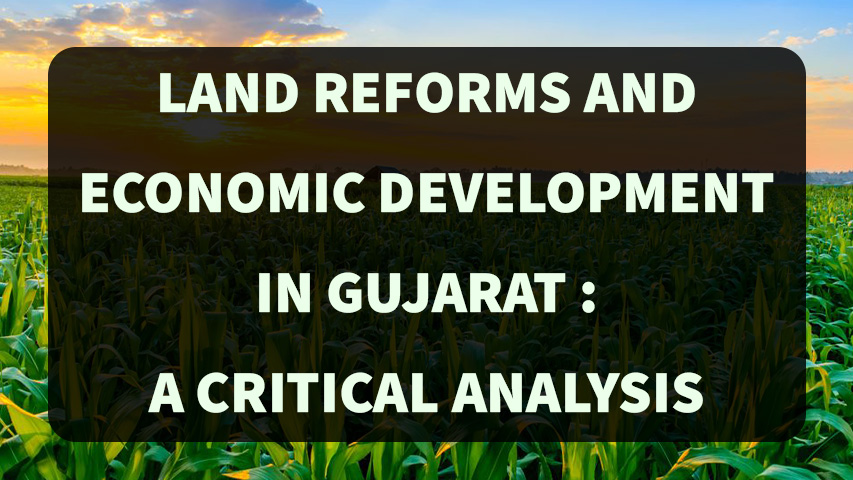
Land Reforms and Economic Development in Gujarat: A Critical Analysis
The economic success of a nation is greatly influenced by land reforms, which also provide fair access to and distribution of land resources. Gujarat has undertaken extensive land reforms and focuses on agricultural expansion and economic development. This article deals with the interrelations between the different land reforms and economic development in Gujarat.
Contents
The economic success of a nation is greatly influenced by land reforms, which also provide fair access to and distribution of land resources. Gujarat has undertaken extensive land reforms and focuses on agricultural expansion and economic development. This article deals with the interrelations between the different land reforms and economic development in Gujarat.
Contents
1. Background and Historical Context
2. Land Reform Initiatives and Implementation
3. Impact on Agricultural Growth
4. Challenges and Limitations
5. Special Economic Zones (SEZs) in Land Reforms
6. Way Forward
2. Land Reform Initiatives and Implementation
3. Impact on Agricultural Growth
4. Challenges and Limitations
5. Special Economic Zones (SEZs) in Land Reforms
6. Way Forward
7. Critical Remarks
Background and Historical Context
Land reforms in Gujarat officially started after the independence of India in 1947. These reforms focused on the problems that were happening in the agrarian society. Those problems involve landlessness, tenancy, and unfair land allocation. Thus, the government launched a number of policies and measures to redistribute land to marginal farmers and landless people.
Land Reform Initiatives and Implementation
Gujarat's land reforms involved several key initiatives, including land ceiling laws, land redistribution, tenancy reforms, and the promotion of agricultural productivity. The state government introduced the Gujarat Agricultural Lands Ceiling Act in 1960, which aimed to limit land ownership to a specified ceiling per family. The surplus land exceeding the ceiling was redistributed to the landless and marginal farmers, enabling them to access productive land resources.
Furthermore, tenancy reforms were also implemented to protect the rights of sharecroppers and provide them with security of tenure. These reforms aimed to improve overall agricultural productivity by incentivizing investments in land and increasing farmers' access to credit and government support.
Impact on Agricultural Growth
The land reforms in Gujarat had a significant impact in transforming the agrarian economy. After, distributing land to landless farmers, the reforms helped to decrease poverty. The land beneficiaries were empowered with productive assets, which led to increased agricultural output, improved food security, and enhanced rural livelihoods.
Additionally, the introduction of tenancy reforms provided security of tenure for sharecroppers, encouraging them to invest in land improvement activities and adopt modern farming practices. This resulted in improved agricultural productivity and efficiency, ultimately leading to increased income levels and rural development.
Challenges and Limitations
While land reforms in Gujarat have produced positive outcomes, some challenges and limitations need to be acknowledged. One of the important challenges is due to urbanization and industrial growth the availability of suitable agricultural land was declining.
Another limitation is the lack of implementation and enforcement of land-related legislation. Instances of non-compliance with the land ceiling laws and inadequate monitoring mechanisms have hindered the achievement of the intended objectives of land reforms. Moreover, the political influence and dominance of certain groups have at times impeded the fair redistribution of land, perpetuating inequalities and limiting the potential benefits of land reforms.
Special Economic Zones (SEZs) in Land Reforms
Special Economic Zones (SEZs) have played a vital role in Gujarat's economic development, attracting private investment and facilitating industrial growth. However, SEZs have also raised concerns regarding land acquisition and displacement of farmers. Critics argue that land acquisitions for SEZs have often been carried out without adequate compensation and rehabilitation measures for affected populations.
It is crucial to strike a balance between industrial growth and the protection of farmers' rights and livelihoods. This requires careful planning, transparent processes, and fair compensation mechanisms to ensure inclusive development.
Way Forward
To enhance the impact of land reforms on economic development in Gujarat, policymakers should address critical issues. Strengthening land governance frameworks, improving land records, and simplifying legal procedures are crucial steps. Additionally, a comprehensive assessment of land requirements for industrialization versus agricultural needs is essential to prevent excessive land conversion.
Supporting small and marginal farmers through cooperative models and skill development initiatives can enhance agricultural productivity and income. Investments in rural infrastructure, irrigation facilities, and market linkages are also imperative to boost the agricultural sector.
Critical Remarks
Land reforms have played a significant role in shaping Gujarat's socioeconomic landscape. While successful in some areas, challenges persist, such as the slow pace of land redistribution, disputes over ownership, and the impact of industrialization on agricultural land. Resolving these challenges requires comprehensive policy interventions, improved governance, and inclusive planning.
True economic development in Gujarat lies in striking a balance between industrial growth and agricultural sustainability. By leveraging the cooperative model, investing in rural infrastructure, and ensuring fair land acquisition practices, Gujarat can continue to promote economic development while safeguarding the rights and livelihoods of farmers.
